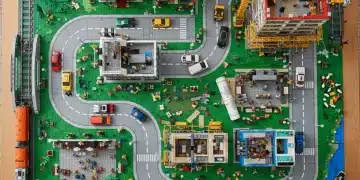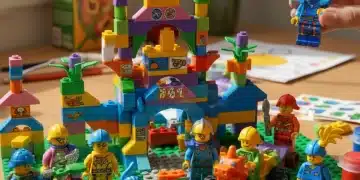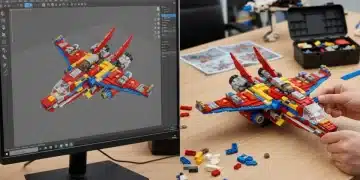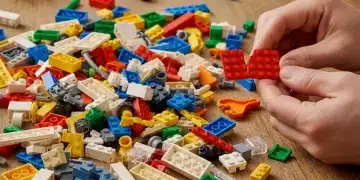Advanced LEGO Building Techniques: SNOT and Beyond for Kids
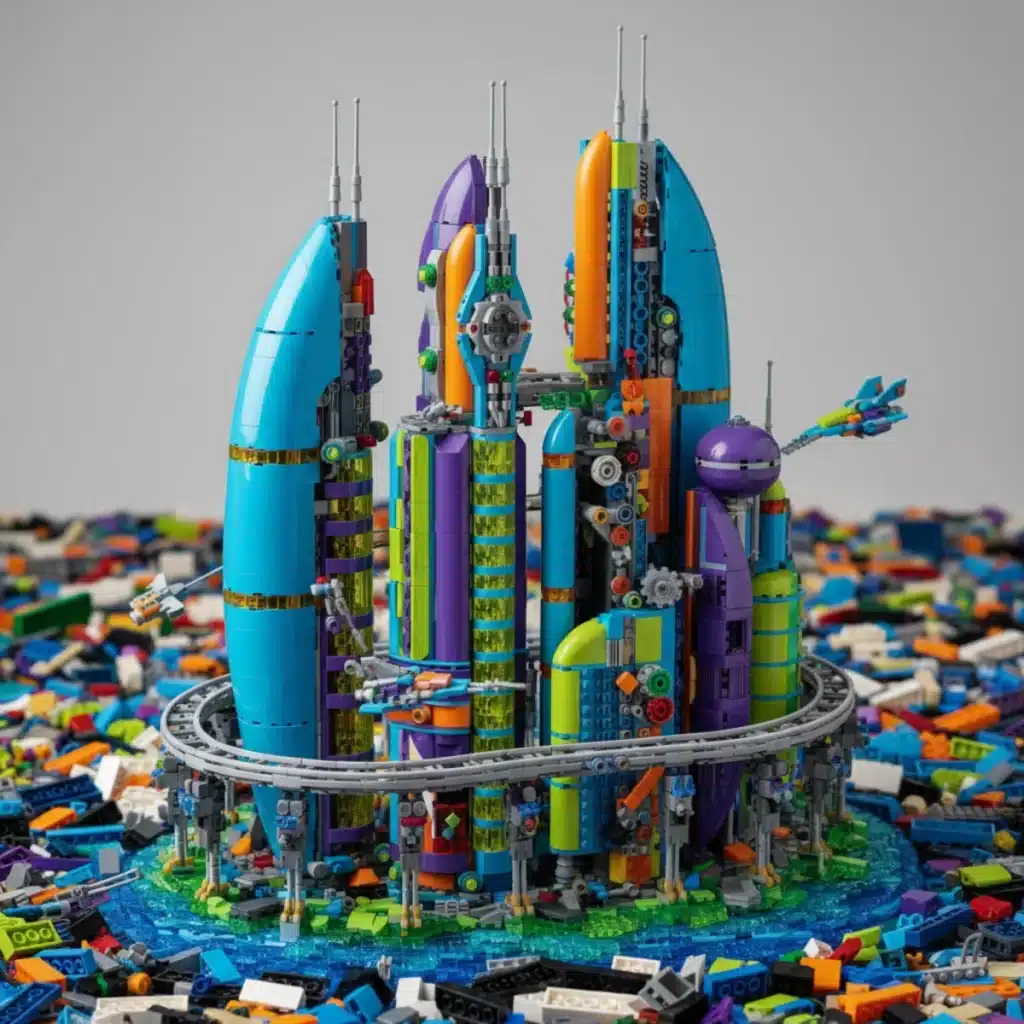
Advertisements
Advanced LEGO building techniques, including SNOT, GBC, and micro-scale, allow builders to create incredibly detailed and functional models that go far beyond basic brick stacking.
Anúncios
Are you ready to take your LEGO creations to the next level? If you’ve mastered basic stacking and want to build models that truly stand out, exploring advanced LEGO building techniques: SNOT and beyond is your next adventure. These methods will unlock a world of creative possibilities, transforming simple bricks into intricate masterpieces.
Understanding SNOT: Studs Not On Top
SNOT, which stands for “Studs Not On Top,” is one of the most fundamental yet revolutionary advanced LEGO building techniques. It involves attaching bricks so their studs face in directions other than upwards, allowing for smooth surfaces, intricate angles, and detailed textures that would be impossible with traditional stacking. This technique is crucial for adding realism and complexity to your models, making them look less like a collection of bricks and more like a sculpted object.
Anúncios
Mastering SNOT opens up new avenues for design, from creating flush walls and detailed facades to crafting unique shapes and curves. It’s not just about aesthetics; SNOT also enhances structural integrity when used cleverly, allowing for more robust and stable creations. This technique is widely used by experienced LEGO builders, often without even realizing they are applying a formal method, because it becomes an intuitive part of their building process.
Basic SNOT Applications
The simplest way to start with SNOT is by using bricks with studs on their sides, such as headlight bricks or modified bricks with studs on the side. These pieces act as anchors, allowing you to connect other elements perpendicularly to your main build. Experimenting with these basic pieces will quickly show you the potential of SNOT.
- Headlight bricks: These small, versatile bricks are perfect for creating recessed details or attaching plates at a 90-degree angle.
- Modified bricks with studs on side: Available in various sizes, these allow for broader SNOT connections and can support larger sub-assemblies.
- Brackets: These pieces are designed specifically to change the direction of studs, providing strong connections for SNOT applications.
Advanced SNOT Strategies
Once you’re comfortable with basic SNOT, you can move on to more complex applications. This might involve creating entire SNOT walls for seamless exteriors or using a combination of SNOT techniques to achieve organic shapes. The key is to think about how you can use the side studs to hold elements that normally wouldn’t fit or would look out of place.
Consider using SNOT to build letters, logos, or even textured surfaces that mimic real-world materials like wood or stone. The possibilities are truly endless, limited only by your imagination and the types of bricks you have available. Many builders create custom sub-assemblies that are entirely SNOT-based, which are then integrated into a larger model.
In essence, SNOT is a gateway to more sophisticated LEGO design. It encourages builders to think beyond the conventional, to manipulate bricks in new ways, and to achieve a level of detail and finish that elevates their creations from toys to true works of art. It’s a skill that grows with practice, leading to increasingly complex and satisfying builds.
Great Ball Contraptions (GBC): Engineering with LEGO
Great Ball Contraptions, or GBCs, represent a fascinating intersection of LEGO building and engineering principles. These complex machines are designed to transport small LEGO balls in a continuous loop, often using a variety of clever mechanisms like lifts, conveyors, and catapults. Building a GBC module challenges you to think about mechanical movement, timing, and structural stability, pushing your LEGO skills far beyond static models.
Each GBC module typically performs a specific task, and modules can be connected together to form an elaborate, collaborative display of engineering ingenuity. The joy of GBCs comes from watching the balls smoothly transition from one module to the next, a testament to careful planning and precise construction. These contraptions are not just fun to watch; they are incredible learning tools for understanding physics and mechanics.
The Basics of GBC Modules
A typical GBC module needs an input area where balls enter, a mechanism to move them, and an output area where they exit. The key is to ensure reliable movement, so the balls don’t get stuck or fall out. This requires careful consideration of slopes, friction, and the forces acting on the balls. Many builders start with simple lift mechanisms, such as a bucket elevator or a rotating arm, before tackling more complex designs.
- Input/Output: Standardized entry and exit points ensure compatibility between different GBC modules.
- Ball Flow: Designing pathways for smooth ball movement, often using ramps, tubes, or track pieces.
- Power Source: Motors or hand-cranks are typically used to drive the mechanisms, requiring careful gear ratios.
Designing and Building Your First GBC
When designing a GBC, it’s helpful to sketch out your ideas first. Think about what kind of motion you want to achieve and what LEGO elements might help you do that. Gears, axles, and Technic pins are essential for creating robust and functional mechanisms. Testing your module frequently during the building process is crucial, as even small misalignments can cause the balls to jam.
Many GBC builders draw inspiration from real-world machines or invent entirely new ways to move balls. The GBC community is vibrant, with many builders sharing their designs and collaborating on massive GBC layouts at LEGO conventions. Participating in this community can provide endless inspiration and opportunities to learn from others’ expertise.
Ultimately, building GBCs is about problem-solving and perseverance. It’s incredibly rewarding to see your mechanical creation flawlessly transport balls, knowing that you designed and built every intricate part. It’s a true demonstration of how LEGO can be used as a powerful tool for creative engineering and a fantastic way to engage with complex concepts in a playful manner.
Micro-Scale Building: Detail in Miniature
Micro-scale building involves creating models that are significantly smaller than their real-world counterparts, often using tiny LEGO elements to represent large structures or landscapes. This technique challenges builders to convey detail and recognizable forms with a limited number of pieces, focusing on essential features and clever parts usage. It’s about capturing the essence of a subject in a compact, stylized form.
The beauty of micro-scale lies in its ability to evoke grandeur on a small footprint. You can build entire cities, vast landscapes, or iconic landmarks that fit on a desk, requiring a keen eye for proportion and an understanding of how to suggest rather than explicitly render details. This style is particularly popular for architectural models, dioramas, and even miniature starships.
Key Principles of Micro-Scale
In micro-scale, every single stud and connection matters. Builders often use plates, tiles, and small modified bricks to represent features like windows, doors, or trees. The choice of color also plays a significant role in defining different elements and creating visual interest. Simplicity and suggestion are more important than attempting to replicate every minute detail.
- Part selection: Using small, specialized pieces to represent larger components (e.g., a 1×1 round plate for a tree).
- Color economy: Strategic use of colors to define areas and create visual depth without overcomplicating the palette.
- Focal points: Highlighting key features to ensure the model is recognizable, even at a reduced scale.
Techniques for Achieving Detail
SNOT often plays a crucial role in micro-scale to achieve smooth surfaces or specific angles that wouldn’t be possible with studs facing upwards. For example, a SNOT wall can represent a smooth skyscraper facade, while tiny plates attached via SNOT can form intricate greebling on a spaceship. The challenge is to make these connections strong and invisible.
Another common technique is ‘greebling,’ which involves adding small, seemingly random pieces to a surface to create a sense of mechanical or technological detail. In micro-scale, greebling is used sparingly and strategically to avoid overwhelming the small model. Understanding perspective and how the human eye interprets shapes is also vital for successful micro-scale building.
Micro-scale building is a fantastic way to develop your creative problem-solving skills and your ability to work within constraints. It teaches you to appreciate the power of suggestion and how to make a big impact with small bricks. It’s a rewarding challenge that can lead to surprisingly detailed and impressive miniature worlds.

Advanced Structural Integrity: Making Your Builds Stronger
Beyond aesthetics, advanced LEGO building techniques also focus on creating models that are incredibly strong and stable. While basic stacking works for simple builds, complex creations with intricate details, open spaces, or dynamic elements require a deeper understanding of structural engineering. This ensures your masterpiece can withstand handling, display, and even transport without falling apart.
Achieving advanced structural integrity means thinking about how forces are distributed throughout your model, how connections are made, and how to reinforce weak points. It’s about building smart, not just big. This approach is especially important for models that will be moved, played with extensively, or are designed to hold weight, like a GBC module or a large architectural display.
Layering and Interlocking
One of the most fundamental principles for structural strength is proper layering and interlocking. Instead of simply stacking bricks directly on top of each other, offset them so that each brick spans across the connection points of the bricks below it. This creates a much stronger bond, distributing stress over a larger area and preventing seams from forming weak points.
- Stud-to-tube connections: Ensure every stud is firmly seated in a tube for maximum grip.
- Plate reinforcement: Use plates to tie together multiple layers of bricks, especially at corners and edges.
- Cross-bracing: Incorporate elements that span across sections to prevent twisting or bending, similar to how real-world structures are reinforced.
Technic Integration for Strength
For truly robust structures, integrating Technic elements into your System builds is invaluable. Technic bricks, pins, axles, and beams offer superior connection strength and allow for much more rigid frames. They are excellent for creating internal skeletons for large models or for areas that will experience significant stress, such as the base of a tall tower or the frame of a vehicle.
Think of Technic as the steel rebar in concrete; it provides hidden strength that allows the outer System bricks to define the aesthetic. Using Technic pins to connect plates and bricks can create incredibly strong sub-assemblies that are difficult to break apart. This hybrid approach allows for the best of both worlds: the detailed aesthetics of System bricks with the unparalleled strength of Technic.
Ultimately, a strong build is a lasting build. Investing time in understanding and applying advanced structural techniques will save you frustration and ensure your creations remain intact for years to come. It’s a foundational skill that supports all other advanced building endeavors, making your models not just beautiful, but also robust.
Greebling and Texturing: Adding Realistic Detail
Greebling and texturing are advanced LEGO techniques that add fine, intricate details to models, giving them a more realistic, complex, and visually interesting appearance. Greebling specifically refers to the practice of adding small, seemingly random pieces to a surface to create the illusion of mechanical components, pipes, vents, or other technological elements. Texturing, on the other hand, uses various brick types and orientations to mimic natural surfaces like rock, wood, or even fabric.
These techniques are crucial for breaking up monotonous surfaces and adding visual depth, transforming a flat, plain area into something that looks functional and lived-in. They are widely used in sci-fi models, architectural builds, and even organic creations to enhance their believability and artistic quality. It’s about using the LEGO palette to tell a story through surface detail.
The Art of Greebling
Greebling is particularly effective on spaceships, robots, and industrial structures. It involves attaching small plates, tiles, grilles, slopes, and even non-traditional elements like minifigure accessories or tool parts to create a busy, detailed surface. The trick is to make it look intentionally complex, not messy. This often means using consistent colors or patterns in the greebles to maintain visual harmony.
- Variety of parts: Utilize a wide range of small elements such as 1×1 plates, cheese slopes, grilles, and even robot arms.
- Strategic placement: Place greebles in logical areas where mechanical detail would naturally occur, like engine vents or panel lines.
- Color consistency: Often, greebles are built with a limited color palette (e.g., dark gray, light gray, black) to make them look like integrated components.
Texturing for Natural Surfaces
Texturing focuses on replicating natural surfaces. For example, using SNOT techniques with various shades of brown and tan bricks can create a convincing wooden effect. Staggering bricks or using irregular SNOT connections can mimic rough rock formations. Even simple techniques like varying the height of plates can create subtle textures that catch the light differently.
Another popular texturing method is using “jumper plates” (1×2 plates with one stud) to offset elements slightly, creating a brick-built texture that looks more organic than perfectly aligned studs. This is often used for brick walls or cobblestone paths. The goal is to make the surface interesting to the eye, inviting closer inspection and adding a layer of realism to the model.
Both greebling and texturing require patience and an experimental mindset. They encourage you to look at individual LEGO pieces not just for their primary function, but for their potential as detailed surface elements. Mastering these techniques will significantly elevate the visual appeal and perceived complexity of your LEGO creations, making them truly captivating to observers.
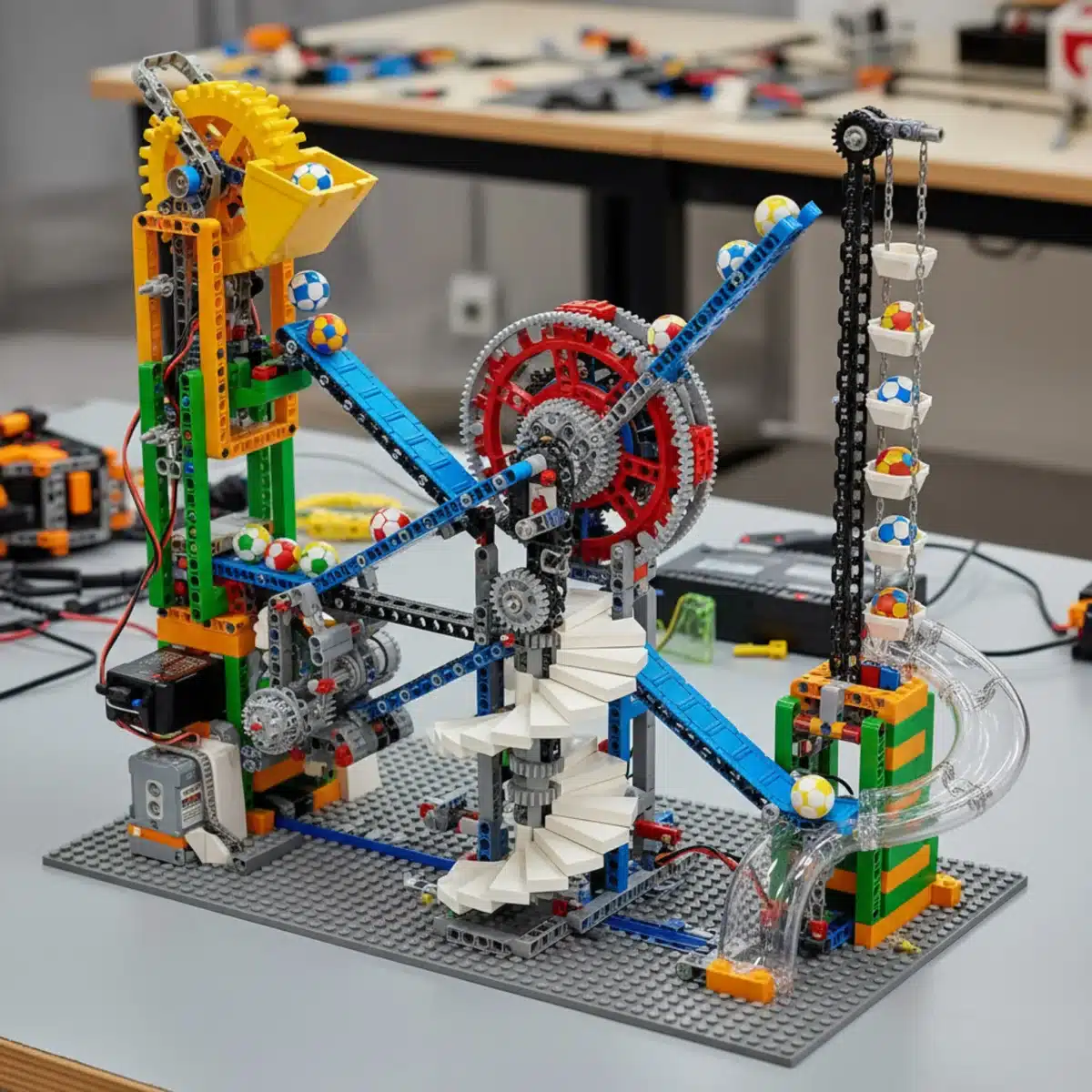
Modular Building and Advanced Connections
Modular building is an advanced technique where a larger LEGO model is constructed from smaller, independent sub-assemblies or modules. These modules are then connected to form the complete structure, often allowing for easy reconfiguration, expansion, or transportation of the model. This approach is particularly popular for large-scale city layouts, complex dioramas, and even intricate vehicles.
The beauty of modular building lies in its flexibility and scalability. It allows builders to tackle immense projects by breaking them down into manageable parts. It also encourages collaboration, as different builders can each create a module that fits into a larger, shared project. This method requires careful planning to ensure that all connection points align perfectly and that the overall structure remains cohesive.
Advantages of Modular Design
One of the primary benefits of modular building is the ease of transport. A large, intricate model can be disassembled into smaller, more manageable sections, making it much easier to move to exhibitions or events. Once at the destination, the modules can be quickly reassembled. This also makes it easier to modify or upgrade sections of a model without having to dismantle the entire build.
- Transportability: Easier to move large models by breaking them into smaller, robust sections.
- Flexibility: Modules can be rearranged or swapped out, allowing for dynamic displays and customization.
- Collaboration: Multiple builders can work on different modules simultaneously, contributing to a larger project.
Advanced Connection Methods
Creating seamless and strong connections between modules is critical. Builders often use Technic pins, clips, and specific brick types that allow for secure yet easily detachable links. Sometimes, magnets are even incorporated for quick and precise alignment. The goal is for the seams between modules to be as invisible as possible, maintaining the illusion of a single, continuous structure.
For example, a common method involves using 1×2 Technic bricks with holes on the sides, allowing Technic pins to connect adjacent modules. Another approach uses modified plates with clips and bars to create strong, interlocking sections. Planning these connection points during the initial design phase is crucial to ensure everything fits together perfectly.
Modular building truly showcases a builder’s foresight and precision. It’s a testament to planning, execution, and the ability to imagine how individual parts contribute to a grander whole. For those looking to create truly ambitious LEGO projects, mastering modular design is an indispensable skill that will open up new frontiers in scale and complexity.
Beyond the Bricks: Exploring Customization and MOCs
Moving “beyond the bricks” means exploring the vast world of custom LEGO creations, known as MOCs (My Own Creations), and understanding how to truly personalize your building experience. This involves not just applying advanced techniques, but also developing your unique style, experimenting with parts in unconventional ways, and even venturing into digital design. It’s about finding your voice as a LEGO artist.
The journey from following instructions to creating your own MOCs is where the true magic of LEGO lies. It’s where imagination takes center stage, and every brick becomes a tool for expressing a unique vision. Customization can range from simple color changes to elaborate, multi-themed dioramas, reflecting the builder’s specific interests and creative flair.
Developing Your Unique Style
Every advanced builder eventually develops a personal style, a signature way of using bricks or combining techniques. This might manifest in a preference for certain color palettes, a distinctive approach to SNOT, or an innovative way of using Technic functions. Experimentation is key to discovering what resonates with you and what makes your creations unique.
- Experiment with themes: Try building in genres you haven’t explored before, like steampunk, cyberpunk, or historical reconstructions.
- Study other MOCs: Learn from the vast online community of LEGO builders, but always strive to put your own spin on ideas.
- Don’t be afraid to fail: Some of the best discoveries come from attempts that didn’t quite work out as planned, leading to new solutions.
Digital Design and Virtual Building
The advent of digital LEGO design tools like BrickLink Studio and LDraw has revolutionized how many advanced builders approach MOCs. These programs allow you to design models virtually, experiment with parts and colors without physical limitations, and even generate building instructions. Digital building is a fantastic way to plan complex projects, test structural integrity, and visualize your ideas before committing to buying bricks.
Many builders use digital tools to create renders of their models, share designs with others, or even order custom parts. It’s a powerful complement to physical building, offering a playground for pure creativity before the tangible assembly begins. This blend of virtual and physical creation pushes the boundaries of what’s possible with LEGO.
Ultimately, venturing beyond the bricks means embracing continuous learning, pushing creative boundaries, and finding joy in the process of creation. It’s about recognizing that LEGO is not just a toy, but a versatile medium for artistic expression, engineering, and storytelling. Your MOCs are a reflection of your unique imagination, and that is truly powerful.
| Key Technique | Brief Description |
|---|---|
| SNOT | (Studs Not On Top) Attaching bricks so studs face sideways for smooth surfaces and intricate details. |
| GBC | (Great Ball Contraptions) Building complex machines to transport LEGO balls in a continuous loop. |
| Micro-Scale | Creating miniature models that convey detail and form using a limited number of small pieces. |
| Greebling | Adding small, intricate pieces to surfaces for realistic mechanical or technological detail. |
Frequently Asked Questions About Advanced LEGO Building
SNOT (Studs Not On Top) is often considered the most foundational advanced technique. Mastering SNOT unlocks countless possibilities for creating smooth surfaces, intricate angles, and detailed textures, which are essential for elevating the realism and complexity of your LEGO models beyond simple brick stacking.
To enhance structural integrity, focus on proper layering and interlocking of bricks, ensuring connections are offset. Integrating Technic elements like pins and beams within your System builds also provides superior strength and rigidity, especially for larger or more dynamic constructions, preventing them from easily falling apart.
GBCs are complex LEGO machines designed to transport small LEGO balls in a continuous loop using various mechanisms. They are popular because they combine engineering challenges with creative building, showcasing intricate mechanical movements and offering a rewarding experience in problem-solving and collaboration within the LEGO community.
Absolutely. Advanced techniques like SNOT are crucial for micro-scale building to achieve smooth surfaces and specific angles with tiny elements. Greebling is also used sparingly to add subtle, intricate details, allowing builders to convey recognizable forms and create impressive miniature models with limited bricks.
Inspiration can be found by exploring online LEGO communities, attending LEGO conventions, or studying real-world objects and architecture. Digital design tools like BrickLink Studio also offer a platform to experiment with virtual builds, helping you plan complex projects and visualize new ideas before assembling them physically.
Conclusion
Embarking on the journey of advanced LEGO building techniques, from the foundational principles of SNOT to the intricate mechanics of GBCs and the detailed artistry of micro-scale, truly transforms the way you interact with these iconic bricks. These methods are more than just tricks; they are a gateway to unlocking unparalleled creativity, structural ingenuity, and artistic expression. By understanding how to manipulate bricks in new dimensions, integrate robust structural elements, and add realistic textures, you can elevate your creations from simple models to captivating masterpieces. The world of LEGO is vast and ever-expanding, and by embracing these advanced techniques, you’re not just building with bricks—you’re engineering dreams, crafting stories, and continuously pushing the boundaries of your imagination. So grab your bricks, experiment with confidence, and let your advanced LEGO journey begin!
